Development of Instrumented Running Prosthetic Feet for the Collection of Track Loads on Elite Athletes †
Abstract
:1. Introduction
2. Materials and Methods
2.1. Sensor Design Specifications
2.2. Terminology and Reference Systems
2.3. Sensing Concept of the Instrumented Running Prosthetic Foot (iRPF)
2.4. Development of the Instrumented Running Prosthetic Foot (iRPF)
2.5. Static Calibration of the Instrumented Running Prosthetic Foot (iRPF)
2.6. Dynamic Validation of the Instrumented Running Prosthetic Foot (iRPF) during Field Tests
2.7. Track Sprint and Long Jump Data Collection Using the Instrumented Running Prosthetic Foot (iRPF)
3. Results
3.1. Calibration Tests
3.2. Dynamic Validation Tests
3.3. Field Tests
4. Discussion
5. Conclusions
Author Contributions
Funding
Acknowledgments
Conflicts of Interest
Abbreviations
| CRS | Clamp Reference System |
| FRS | Foot Reference System |
| GRF | ground reaction forces |
| GRS | Global Reference System |
| KRS | Shank Reference System |
| iRPF | instrumented running prosthetic foot |
| IMU | inertial motion unit |
| LRS | Pylon Reference System |
| RMSE | root mean square error |
| RPF | running prosthetic feet |
| RSP | running specific prostheses |
| SRS | Socket Reference System |
| TRS | Thigh Reference System |
Appendix A. Description of Reference Systems (Figure 1, Figure 2, and Figure 3), in the Sagittal Plane
References
- Hobara, H. Running-specific prostheses: The history, mechanics, and controversy. J. Soc. Biomech. 2014, 38, 105–110. [Google Scholar] [CrossRef] [Green Version]
- Brüggemann, G.; Arampatzis, A.; Emrich, F.; Potthast, W. Biomechanics of double transtibial amputee sprinting using dedicated sprinting prostheses. Sport. Technol. 2008, 1, 220–227. [Google Scholar] [CrossRef]
- Grabowski, A.M.; McGowan, C.P.; McDermott, W.J.; Beale, M.T.; Kram, R.; Herr, H.M. Running-specific prostheses limit ground-force during sprinting. Biol. Lett. 2010, 6, 201–204. [Google Scholar] [CrossRef] [PubMed]
- Weyand, P.G.; Sternlight, D.B.; Bellizzi, M.J.; Wright, S. Faster top running speeds are achieved with greater ground forces not more rapid leg movements. J. Appl. Physiol. 2000, 89, 1991–1999. [Google Scholar] [CrossRef] [PubMed] [Green Version]
- Hobara, H.; Baum, B.S.; Kwon, H.J.; Miller, R.H.; Ogata, T.; Kim, Y.H.; Shim, J.K. Amputee locomotion: Spring-like leg behavior and stiffness regulation using running-specific prostheses. J. Biomech. 2013, 46, 2483–2489. [Google Scholar] [CrossRef] [PubMed] [Green Version]
- Nagahara, R.; Mizutani, M.; Matsuo, A.; Kanehisa, H.; Fukunaga, T. Association of sprint performance with ground reaction forces during acceleration and maximal speed phases in a single sprint. J. Appl. Biomech. 2018, 34, 104–110. [Google Scholar] [CrossRef] [PubMed]
- Makimoto, A.; Sano, Y.; Hashizume, S.; Murai, A.; Kobayashi, Y.; Takemura, H.; Hobara, H. Ground reaction forces during sprinting in unilateral transfemoral amputees. J. Appl. Biomech. 2017, 33, 406–409. [Google Scholar] [CrossRef]
- Ueda, T.; Hobara, H.; Kobayashi, Y.; Heldoorn, T.A.; Mochimaru, M.; Mizoguchi, H. Comparison of 3 Methods for Computing Loading Rate during Running. Int. J. Sports Med. 2016, 37, 1087–1090. [Google Scholar] [CrossRef] [PubMed]
- Miller, J.R.; van Hooren, B.; Bishop, C.; Buckley, J.D.; Willy, R.W.; Fuller, J.T. A Systematic Review and Meta-Analysis of Crossover Studies Comparing Physiological, Perceptual and Performance Measures Between Treadmill and Overground Running. Sports Med. 2019, 49, 763–782. [Google Scholar] [CrossRef] [PubMed]
- Nolan, L. Carbon Fibre Prostheses and Running in Amputees: A review. Foot Ankle Surg. 2008, 14, 125–129. [Google Scholar] [CrossRef] [PubMed]
- Migliore, G.L.; Petrone, N.; Hobara, H.; Nagahara, R.; Miyashiro, K.; Costa, G.F.; Gri, A.; Cutti, A.G. Innovative alignment of sprinting prostheses for persons with transfemoral amputation: Exploratory study on a gold medal Paralympic athlete. Prosthet. Orthot. Int. 2020. [Google Scholar] [CrossRef] [PubMed]
- Dyer, B.; Sewell, P.; Noroozi, S. How should we assess the mechanical properties of lower-limb prosthesis technology used in elite sport?—An initial investigation. J. Biomed. Sci. Eng. 2013, 6, 116–123. [Google Scholar] [CrossRef] [Green Version]
- Grobler, L.; Ferreira, S.; Vanwanseele, B.; Terblanche, E.E. Characterisation of the responsive properties of two running-specific prosthetic models. Prosthet. Orthot. Int. 2017, 41, 141–148. [Google Scholar] [CrossRef] [PubMed]
- Beck, O.N.; Taboga, P.; Grabowski, A.M. Characterizing the mechanical properties of running-specific prostheses. PLoS ONE 2016, 11, e0168298. [Google Scholar] [CrossRef] [PubMed]
- Petrone, N.; Costa, G.; Foscan, G.; Bettella, F.; Migliore, G.; Cutti, A.G. Conceptual Design of a New Multi-Component Test Bench for the Dynamic Characterization of Running Specific Prostheses. Proceedings 2020, 49, 75. [Google Scholar] [CrossRef]
- Gabert, L.; Lenzi, T. Instrumented Pyramid Adapter for Amputee Gait Analysis and Powered Prosthesis Control. IEEE Sens. J. 2019, 19, 8272–8282. [Google Scholar] [CrossRef]
- James, D.A.; Petrone, N. Sensors and Wearable Technologies in Sport: Technologies, Trends and Approaches for Implementation; Springer: Singapore, 2016. [Google Scholar]
- Sakata, H.; Hashizume, S.; Kobayashi, Y.; Hobara, H. Braking and propulsive impulses across a range of running speeds in unilateral transfemoral amputees. ISBS 2019, 37, 69. [Google Scholar]
- Groothuis, A.; Houdijk, H. The Effect of Prosthetic Alignment on Prosthetic and Total Leg Stiffness While Running With Simulated Running-Specific Prostheses. Front. Sports Act. Living 2019, 1, 19. [Google Scholar] [CrossRef] [Green Version]
- Petrone, N.; Costa, G.; Foscan, G.; Gri, A.; Boekestijn, R.; Migliore, G.; Cutti, A.G. Collection of Structural Loads Acting on Instrumented Running Specific Prostheses during Field Tests on Elite Atletes. Proceedings 2020, 49, 74. [Google Scholar] [CrossRef]

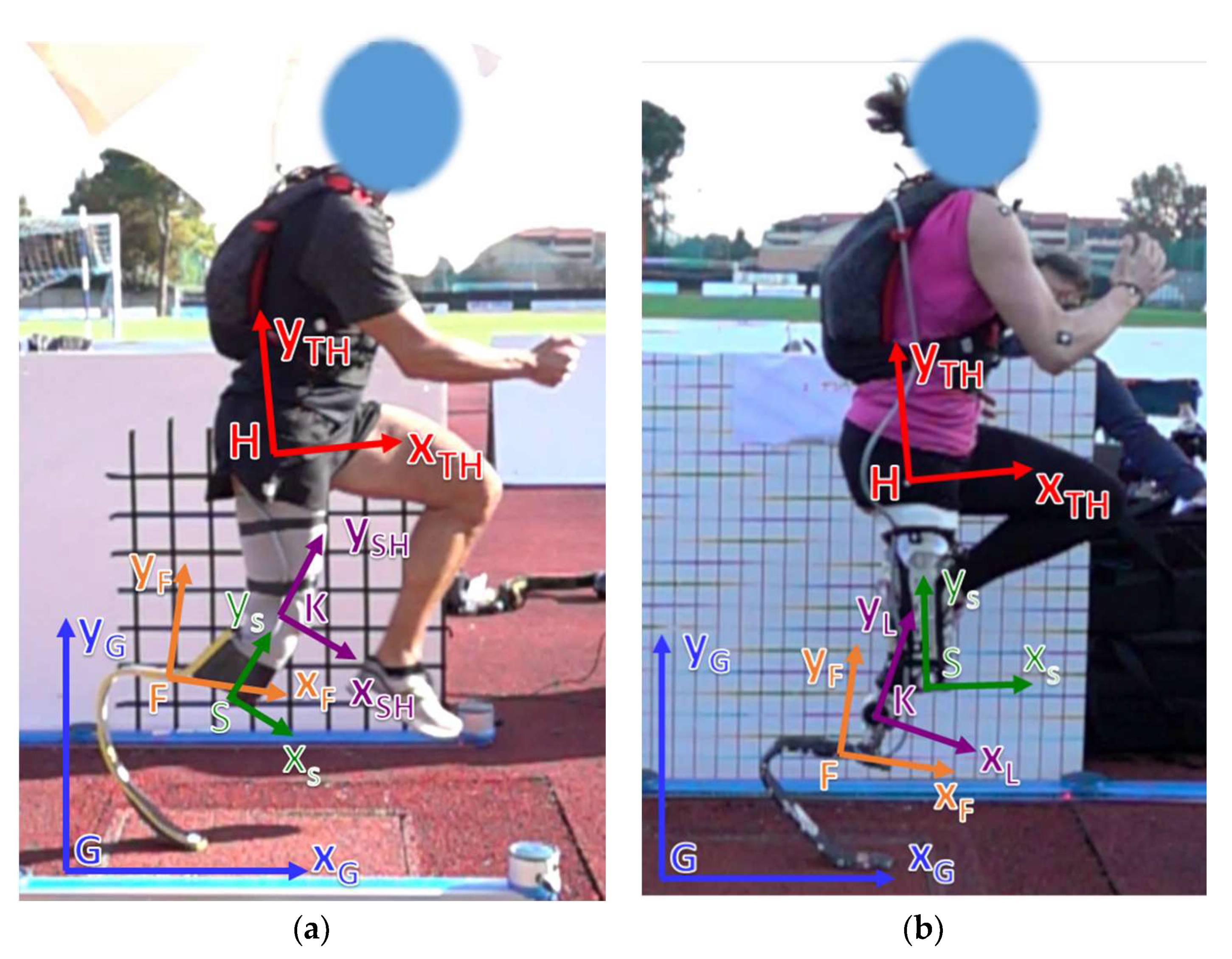
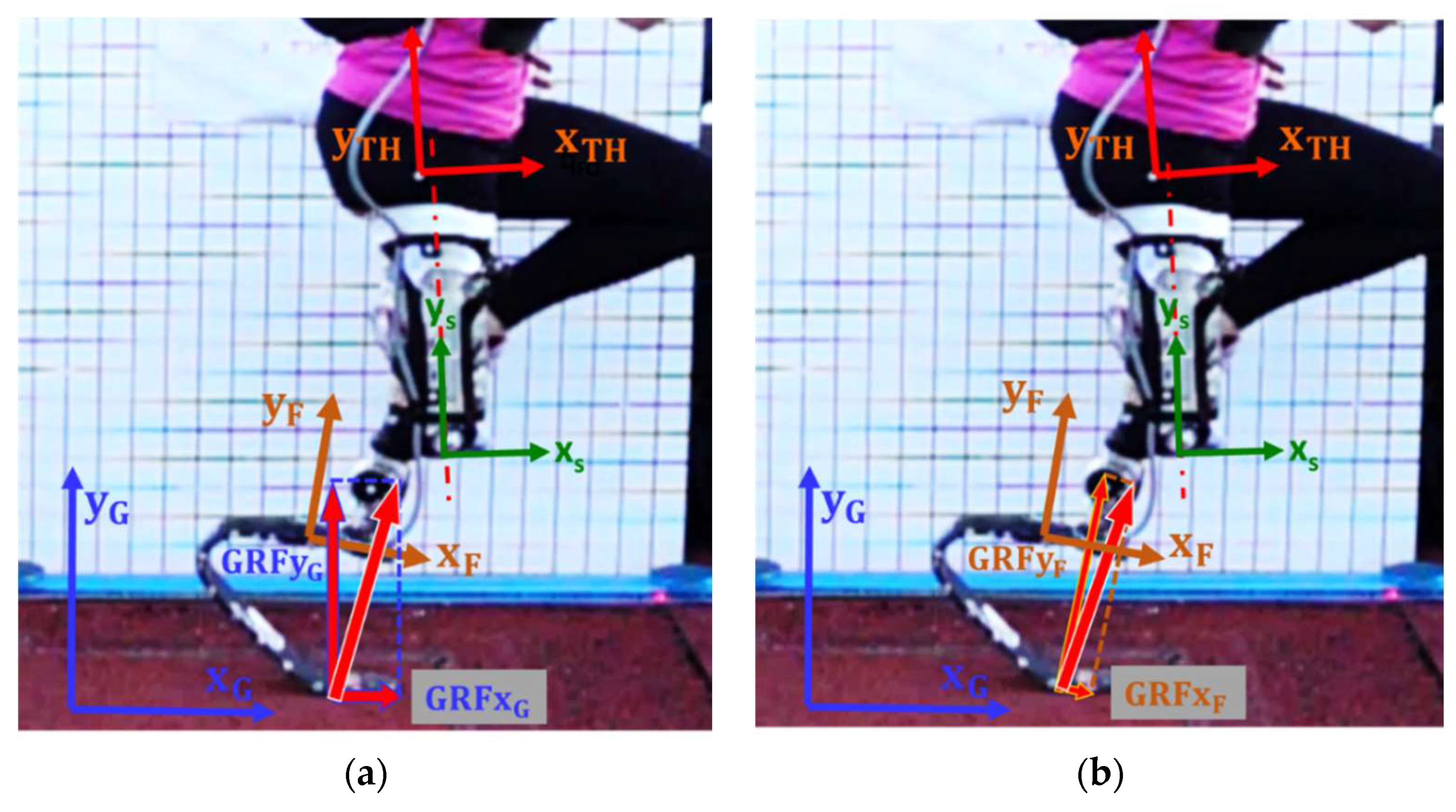


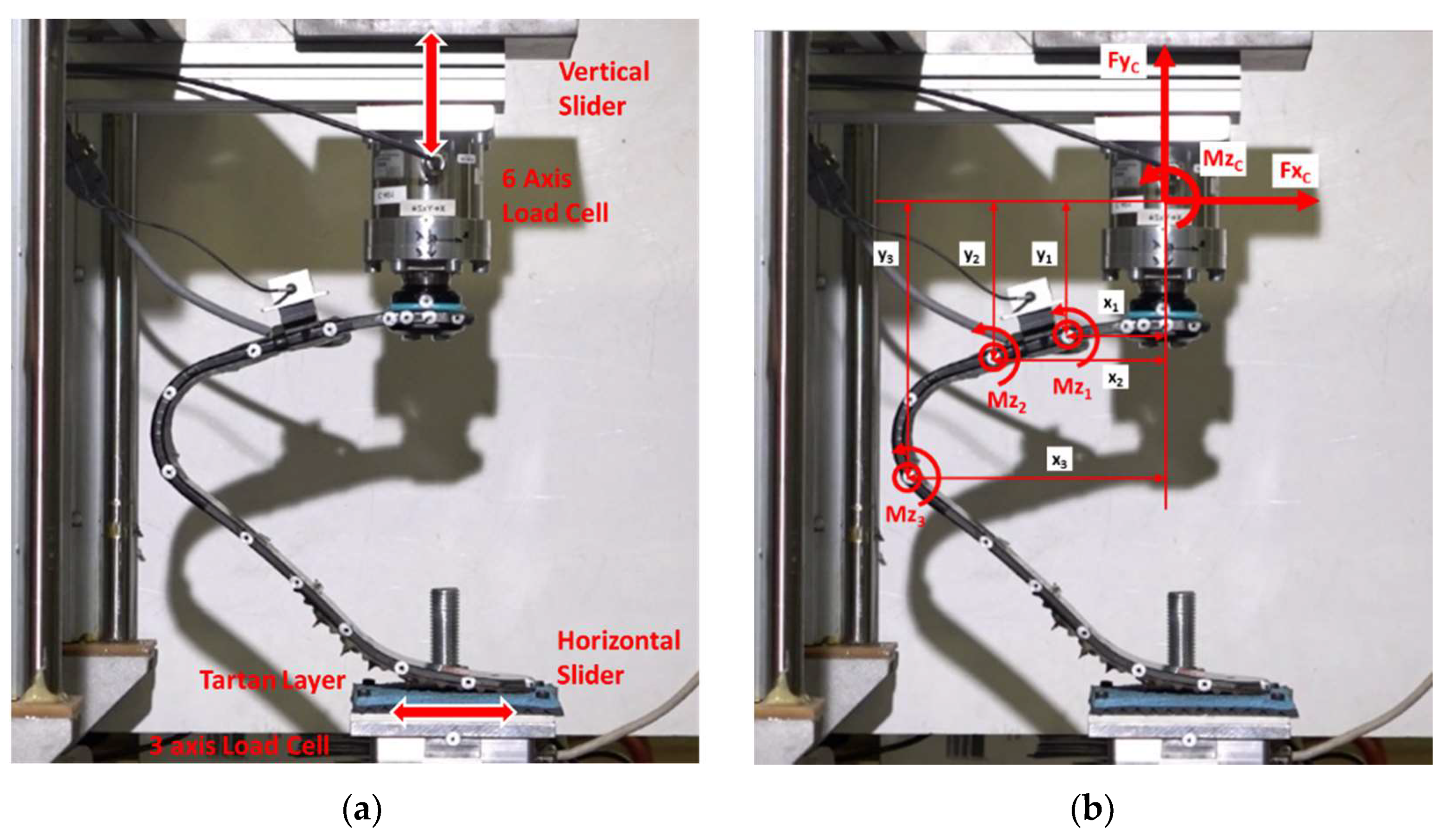





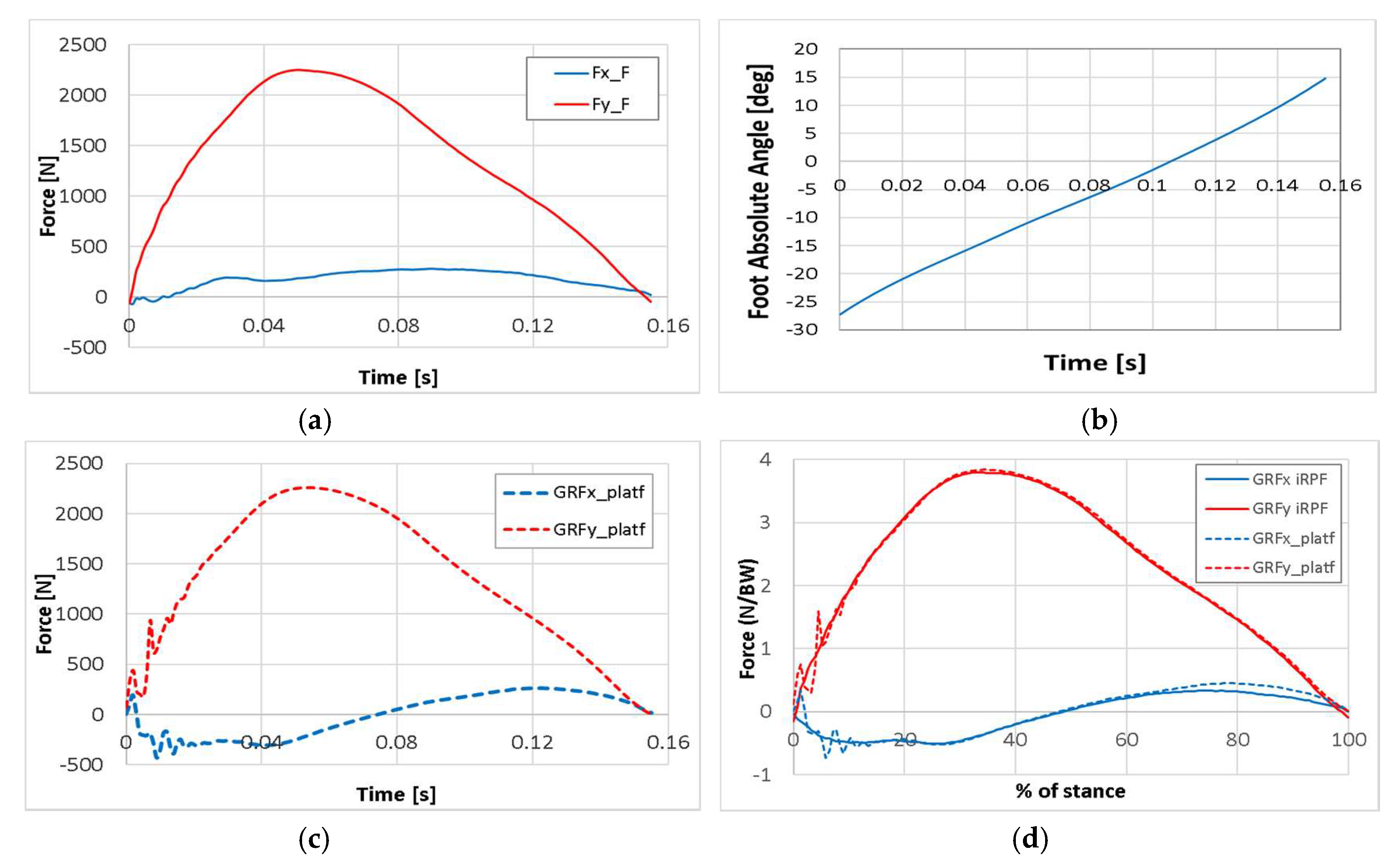


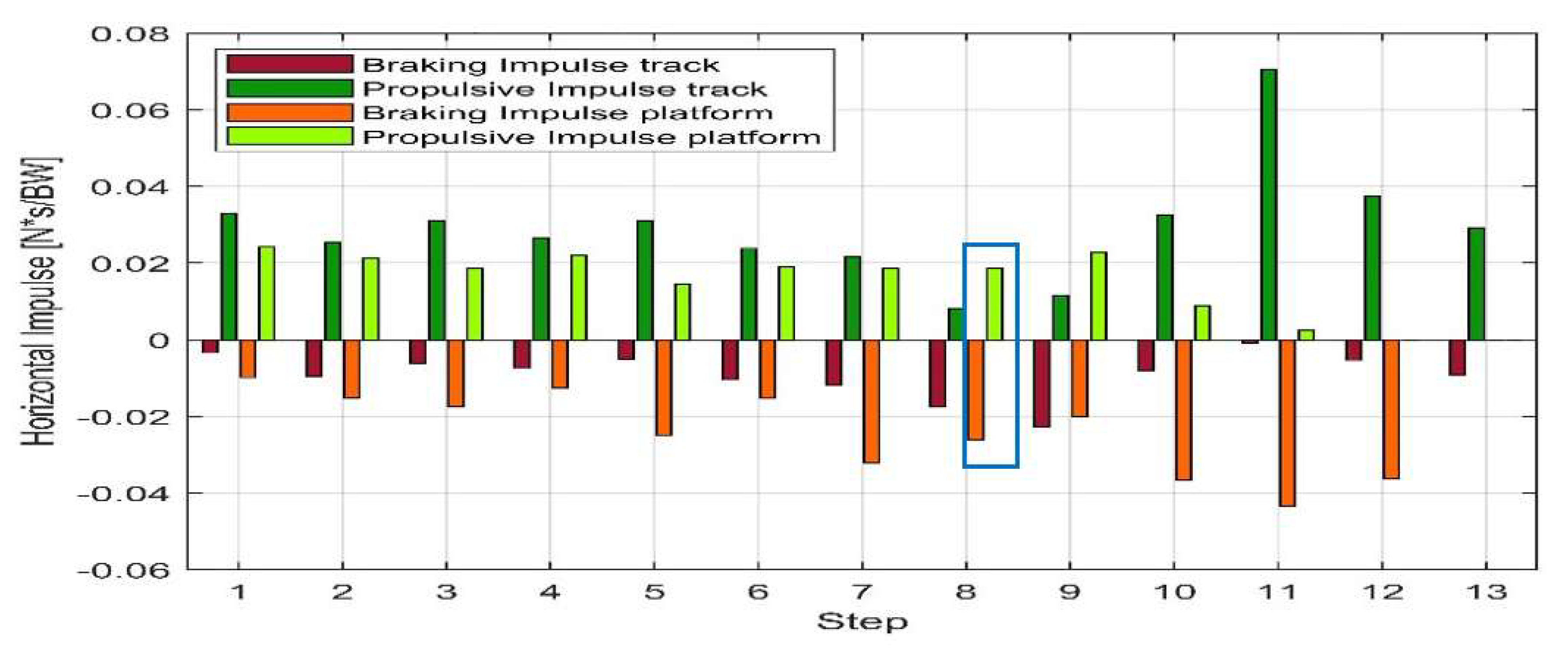
| Foot | a (mm) | b (mm) | c (mm) | K1 (Nm·V/mV) | K2 (Nm·V/mV) | K3 (Nm·V/mV) |
|---|---|---|---|---|---|---|
| Ossur Cheetah Xtreme Cat. 5 | 56 | 128 | 93 | 170,183 (R2 = 0.9999) | 127,795 (R2 = 0.9998) | 85,470 (R2 = 0.9996) |
| Ottobock, 1E91 Runner Std Cat. 4 | 68 | 141 | 60 | 72,254 (R2 = 0.9965) | 79,302 (R2 = 0.9999) | 70,972 (R2 = 0.9999) |
| Test | Peak Fx (%) | Peak Fy (%) | RMSE Fx (%) | RMSE Fy (%) |
|---|---|---|---|---|
| Sprint, TT1 | −8.2 | 6.4 | 7.4 | 3.5 |
| Sprint, KD2 | −12.4 | 4.3 | 12.2 | 2.5 |
| Jump, KD2 | 6.3 | 8.2 | 13.4 | 7.6 |
© 2020 by the authors. Licensee MDPI, Basel, Switzerland. This article is an open access article distributed under the terms and conditions of the Creative Commons Attribution (CC BY) license (http://creativecommons.org/licenses/by/4.0/).
Share and Cite
Petrone, N.; Costa, G.; Foscan, G.; Gri, A.; Mazzanti, L.; Migliore, G.; Cutti, A.G. Development of Instrumented Running Prosthetic Feet for the Collection of Track Loads on Elite Athletes. Sensors 2020, 20, 5758. https://doi.org/10.3390/s20205758
Petrone N, Costa G, Foscan G, Gri A, Mazzanti L, Migliore G, Cutti AG. Development of Instrumented Running Prosthetic Feet for the Collection of Track Loads on Elite Athletes. Sensors. 2020; 20(20):5758. https://doi.org/10.3390/s20205758
Chicago/Turabian StylePetrone, Nicola, Gianfabio Costa, Gianmario Foscan, Antonio Gri, Leonardo Mazzanti, Gianluca Migliore, and Andrea Giovanni Cutti. 2020. "Development of Instrumented Running Prosthetic Feet for the Collection of Track Loads on Elite Athletes" Sensors 20, no. 20: 5758. https://doi.org/10.3390/s20205758
APA StylePetrone, N., Costa, G., Foscan, G., Gri, A., Mazzanti, L., Migliore, G., & Cutti, A. G. (2020). Development of Instrumented Running Prosthetic Feet for the Collection of Track Loads on Elite Athletes. Sensors, 20(20), 5758. https://doi.org/10.3390/s20205758






